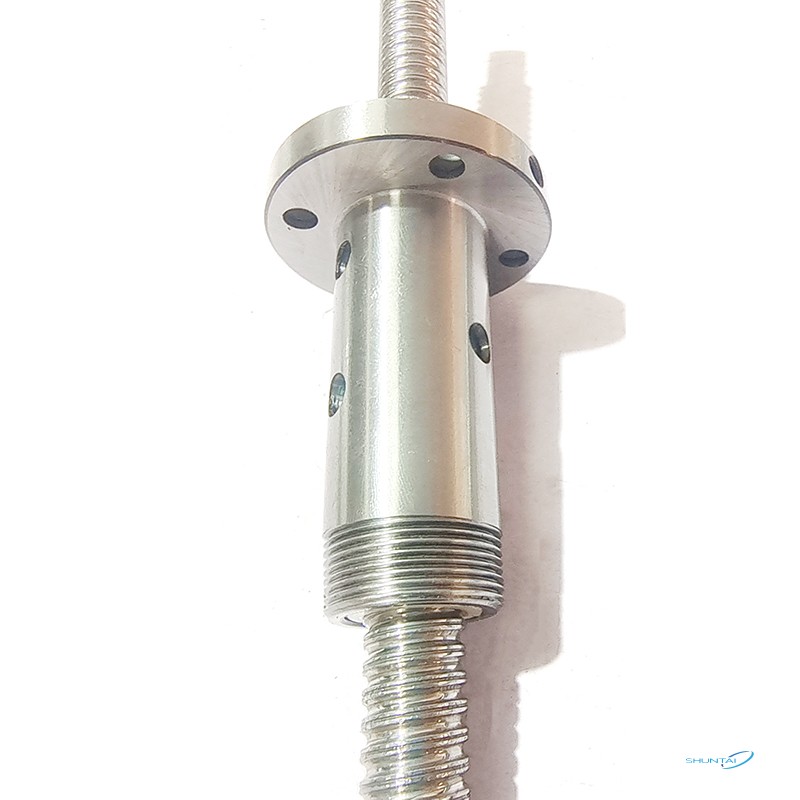Dalam dunia manufaktur presisi, terdapat komponen yang tampaknya tak terlihat namun krusial yang mengubah gerak rotasi menjadi gerak linear yang presisi. Komponen ini memiliki daya yang luar biasa namun tetap berupaya mencapai akurasi setingkat mikron. Komponen tersebut adalah ball screw, "jantung transmisi presisi" yang tak tergantikan dalam peralatan canggih modern.
I. Apa itu sekrup bola? Prinsip inti terungkap
Sederhananya, sekrup bola dapat dianggap sebagai "sekrup super dengan bola baja yang tak terhitung jumlahnya tertanam di ulirnya." Sekrup bola terdiri dari tiga bagian utama:
Sekrup: Poros panjang dengan jalur heliks yang presisi.
Mur: Komponen yang berpasangan dengan sekrup dan juga berisi jalur heliks yang serasi.
Bola: Bola baja presisi yang bersirkulasi di antara jalur sekrup dan mur.

Prinsip operasi inti adalah mengganti gesekan geser dengan gesekan guling. Ketika sekrup atau mur berputar, bola-bola bersirkulasi di dalam jalur transmisi, menggerakkan komponen lainnya untuk menghasilkan gerakan linier yang presisi dan halus. Sistem sirkulasi ini secara signifikan mengurangi hambatan gesek dan meningkatkan efisiensi secara signifikan.
II. Mengapa begitu penting? Keunggulan Performa yang Tak Tertandingi
Presisi Tinggi: Menghilangkan reaksi balik (gerakan yang hilang) dan kemampuan pra-pemuatan memungkinkan pemosisian yang tepat pada tingkat mikron atau bahkan nanometer, landasan pemesinan peralatan mesin CNC pada komponen yang kompleks.
Efisiensi Tinggi: Efisiensi transmisi dapat mencapai lebih dari 90%. Hal ini menghasilkan torsi penggerak yang lebih rendah, efisiensi energi yang lebih tinggi, dan pengurangan panas yang dihasilkan.
Umur Panjang: Gesekan gelinding menyebabkan keausan yang jauh lebih sedikit daripada gesekan geser, menghasilkan umur yang sangat panjang dan keandalan yang tinggi dengan penggunaan dan perawatan yang tepat.
Kekakuan Tinggi: Pra-pemuatan menghilangkan jarak internal, yang memungkinkan bola menahan beban aksial yang signifikan tanpa deformasi, memastikan kekakuan dan stabilitas transmisi.
Gerakan Halus: Koefisien gesekan yang sangat rendah menghasilkan torsi awal yang rendah, pengoperasian yang halus, dan tanpa selip, sehingga ideal untuk gerakan bolak-balik berkecepatan tinggi.
III. Aplikasi: Dari "Mesin Induk Industri" hingga "Bintang dan Lautan"
Sekrup bola digunakan di hampir semua bidang manufaktur kelas atas dan peralatan presisi:
Perkakas mesin CNC: Ini adalah aplikasi paling klasiknya. Pergerakan turret, spindel, dan meja kerja secara langsung menentukan akurasi dan kecepatan pemesinan perkakas mesin.
Robot Industri: Sendi robot serta ekstensi dan retraksi lengan memerlukan gerakan linier yang presisi dan sangat kaku, dan sekrup bola adalah aktuator intinya.
Peralatan Semikonduktor: Mesin fotolitografi, peralatan inspeksi wafer, dan die bonder memerlukan gerakan yang sangat halus dan tepat; bahkan getaran sekecil apa pun dapat berakibat fatal.
Peralatan Medis: Platform pemindaian mesin CT dan MRI medis, serta lengan robotik robot bedah, semuanya memerlukan penggerak linier yang senyap, presisi, dan andal.
Manufaktur Otomotif: Sistem kemudi tenaga listrik, aktuator rem, dan robot perakitan pada jalur produksi otomatis.
Dirgantara: Permukaan kendali pesawat, penarikan dan perpanjangan roda pendaratan, dan mekanisme penyebaran antena satelit memerlukan komponen agar tetap andal di lingkungan ekstrem.
IV. Kesulitan Manufaktur: Seni Presisi Tertinggi
Pemilihan Material: Baja paduan berkualitas tinggi, seperti baja kromium-molibdenum, biasanya digunakan, menawarkan kekuatan tinggi, ketahanan aus yang tinggi, dan sifat perlakuan panas yang sangat baik.
Penggilingan Presisi: Mesin penggilingan CNC dengan presisi sangat tinggi menjamin bentuk, akurasi alur, dan kekasaran permukaan jalur sekrup, memastikan presisi ini.
Perlakuan Panas: Melalui proses seperti karburisasi, pendinginan, dan temper, permukaan mencapai kekerasan yang sangat tinggi (HRC58 dan lebih tinggi) untuk ketahanan aus, sementara inti mempertahankan ketangguhan untuk ketahanan benturan.
Pemesinan Mur: Desain dan pemesinan deflektor internal sangat penting, yang menentukan kelancaran sirkulasi bola dan tingkat kebisingan.
Inspeksi dan Pencocokan: Pada akhirnya, peralatan seperti mesin pengukur koordinat dan interferometer laser diperlukan untuk inspeksi 100% kesalahan arah, akurasi pukulan, dan parameter lainnya, serta pencocokan bola yang tepat untuk mencapai beban awal yang optimal.
Kesimpulan
Sekrup bola, komponen presisi yang tersembunyi di dalam peralatan, merupakan tulang punggung industri modern. Jika Anda tertarik dengan sekrup bola, silakan hubungi kami untuk informasi dan diskusi lebih lanjut.